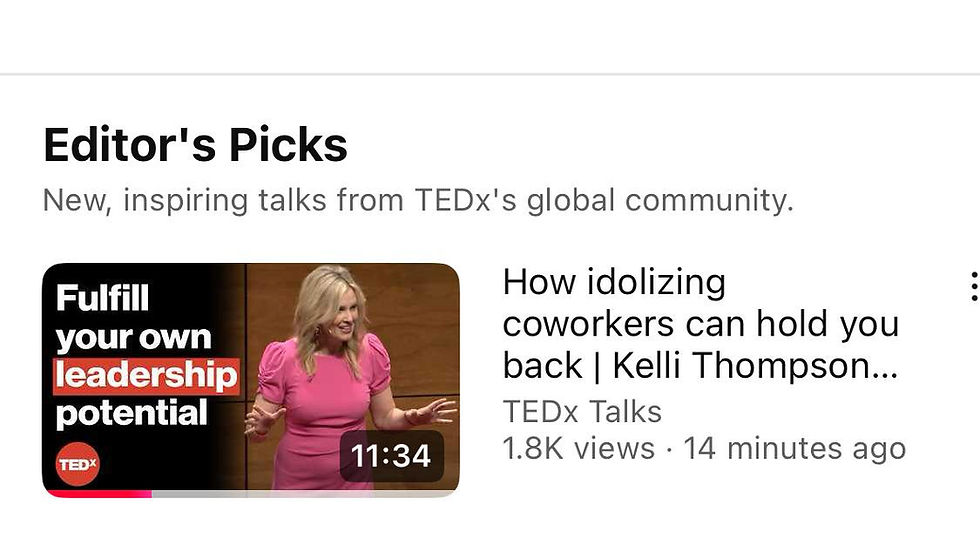Are you in a status quo spiral?
- Kelli Thompson

- Mar 31
- 5 min read
Updated: Aug 25
I spent 12 years at the same organization–they practically raised me! It was a wonderful company to work for and so many of my colleagues became my friends. If I'm being honest though, I started to consider leaving this organization around year nine. Not because it was a bad place to work, but because I felt like I had outgrown it. It was a bank, full of rules and compliance (banks are going to be banks!) and I generally preferred more freedom and creativity.
I thought about leaving, even looked at and interviewed for other roles, but it just felt so risky. As I considered leaving, I worried about the following:
Leaving feels risky, I work for a “best place to work" right now.
What if I leave and I fail?
What if people I work with judge me and I lose them?
What people I don't know judge me and think I'm crazy?
What if I regret my choice, realizing it was a big mistake to leave?
What if it makes me more miserable than I am right now?
With each of these worries, I eliminated my options. I pulled out of interview processes. I'd stop and start and then stop job search endeavors. As I continued to stay, feeling unsettled, bored and agitated, I withdrew from opportunities and projects in my current role. I settled for going through the motions every day to keep the steady pay and benefits.
Years 10-12 felt nearly intolerable. When it was time to leave and make a change, it felt urgent. My status quo felt unbearable and my need for change right this moment was met with the reality of the job market - that it would take six to nine months to find the next right thing. I wondered how I would survive that long.
Many of my clients get stuck in this trap also, staying in a situation, role, career or even a relationship () for too long because it just felt to risky to leave. They consider meaningful moves, but ultimately they eliminate options to keep the peace or feeling of safety. This is an advancement trap I call the Status Quo Spiral.
I see leaders lead organizations into status quo spirals when they eliminate business moves for fear of failure, fear of negative employee opinions or the grind of overcoming of inertia that is required to lead change. Ultimately, they perpetuate the status quo and fall behind their rivals (Blockbuster or Blackberry, anyone?)
Ultimately, status quo spirals happen when we get into analysis paralysis. We start eliminating options. We stop taking risks - they feel so uncomfortable. We play smaller. Then, our life gets smaller. Our world gets smaller. After awhile, it ultimately just feels like we are out of options. There seems to be no path forward, and at this point, the status quo feels unbearable. It can lead to resentment, burnout, job dissatisfaction and depression.
Have you ever felt like you've been stuck in a status quo spiral? Don't worry, keep reading for some ideas to break the trap.

PUT THIS TIP INTO ACTION
I know how paralyzing it can feel when it appears that you are stuck and out of options. Or, that any option available to you feels just too risky. But remember, it was many accumulating options that you did - and did not - choose that led you down the current path.
When you look at the graphic above, it may seem logical that the path out of the status quo spiral would be to reverse course, or just to do the opposite of what got you here. However, approaching it that way is still the same black and white thinking (risky vs safe) that got you here.
Instead I challenge myself, and my clients, to be more mentally flexible in three ways:
1. Start by looking at the opposite: Being mentally flexible can start with looking at the direct opposite of a choice to consider how it may also be an options. In a real life example, when I was considering leaving corporate America, I was lamenting to my husband that being an entrepreneur/coach might limit my income potential. Point blank he looked at me and asked, “What if corporate America is limiting your income?”
I was so focused on the risk of leaving corporate and ruminating on that set of risks it had never occurred to me to consider that my status quo may be riskier than the future I was considering. (PS: He was right.)
2. Try both/and thinking. Many of my clients don't want to make a change because they have a certain feature of their role they like. Perhaps it's their salary, or their co-workers, or their perceived stability, or their stock options, or their commute, or their flexibility. They want X but are unwilling to give up Y. So they falsely believe that leaving means they will never be able to find Y anywhere else.
This is normal, scarcity-minded thinking. I encourage you to consider this, how can I focus my actions on finding opportunities that contain both X AND Y?
3. Assume it will work out. All too often, negativity bias keeps us stuck in our status quo because our brains are wired for automated negative thoughts (I talked about ANTs in Closing The Confidence Gap). We can tend to assume the negative more quickly and never use the rigor to generate evidence that it might just work out, and maybe even better than we are willing to allow ourselves to believe.
Consider this, what actions might you take or solutions will you consider if you knew it would work out better than you hoped? Which one of those solutions moves you closer to the life you want to create?
Try this next: Consider the status quo spiral and then the status quo shift graphic below. What if busting the status quo isn't about trying to reverse course or beat yourself up for your path so far? What if it's more having compassion for yourself and about exploring the many different paths that you could trial and even have some fun with (gasp) today? What if it all works out?


Kelli Thompson is an award-winning author, keynote speaker, and executive coach who specializes in helping high achievers advance to influential leaders in their organizations. She is the author of the critically acclaimed book, Closing The Confidence Gap: Boost Your Peace, Your Potential & Your Paycheck.
Learn more about: Executive Coaching | Speaking & Training | Group Programs





Comments